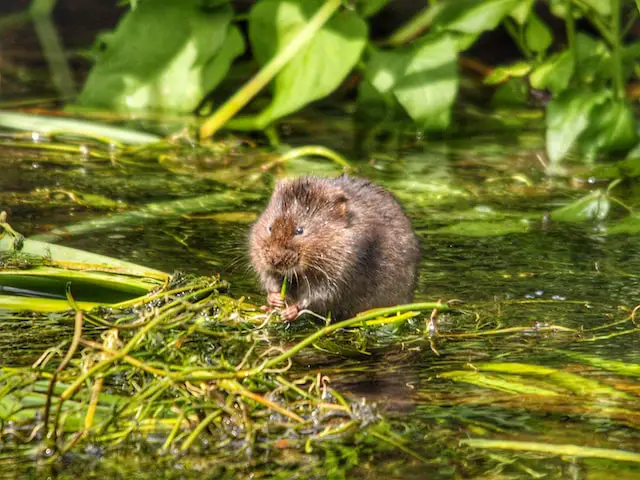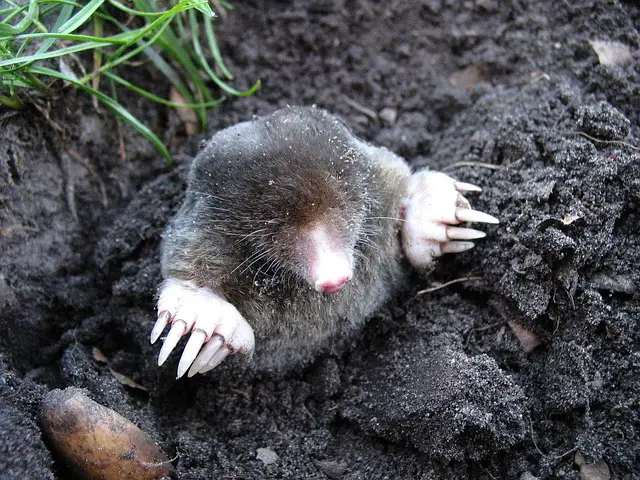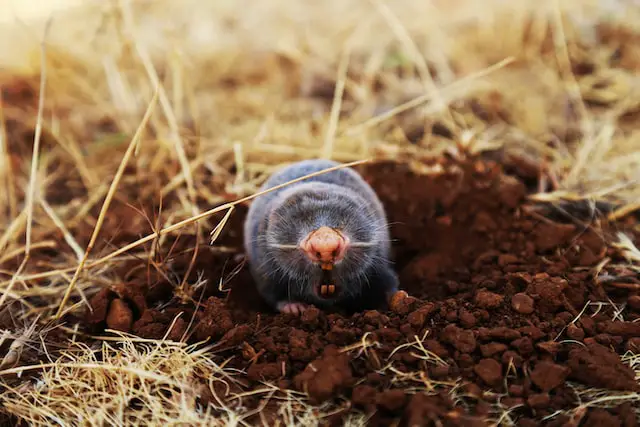Voles typically have shorter legs than moles and their bodies are more rounded. Moles, on the other hand, have longer limbs with larger front feet that help them dig tunnels efficiently.
What are voles?
(Photo by Jonathan Ridley on Unsplash )

Voles are small, mouse-like rodents. They have short fur that is brown or grey in color and a short tail. They are about 4 to 8 inches long, including the tail. Voles live in fields, meadows, and forests. They make tunnels underground, where they live and store food.
Moles are also small, rodent-like animals. But they have dark fur, and their bodies are shaped differently from voles. Moles have long, thin bodies with short legs. Their tails are very short, or they may not have tails at all. Moles live underground in tunnels that they make themselves.
What are moles?
(Image by Dirk (Beeki®) Schumacher from Pixabay )

There are many different types of moles, but they all have one thing in common: they burrow. Moles are small, furry creatures with short legs and long bodies. They live in the ground, and their main source of food is earthworms. Some moles also eat insects, grubs, and other small animals.
Moles are solitary creatures, and they spend most of their time underground in their burrows. They only come out at night to look for food. During the day, they rest in their nests, which are made of grass and leaves.
Moles are not harmful to humans or pets, but they can be a nuisance because of the damage they do to lawns and gardens. When moles tunnel through the ground, they push up dirt and create unsightly mounds on the surface. This can make it difficult to mow your lawn or grow plants in your garden. If you have a mole problem, there are several ways to get rid of them (see below).
The difference between voles and moles
Voles are mouse-like animals with short legs and rounded bodies. They have small eyes and ears, and their fur is generally brown or gray. Voles live in fields, meadows, and forests, and build elaborate tunnel systems underground.
Moles are also small, burrowing rodents, but they have a more cylindrical body shape. Their legs are shorter than their arms, and they have very large front paws that they use for digging. Moles are almost blind, but they have an excellent sense of smell. Their fur is usually black or brown, and they live in woods and gardens.
The main differences between voles and moles are their appearance, habitat, and digging habits. Voles are mouse-like with short legs and rounded bodies; they live in fields and meadows and build extensive tunnel systems below ground. Moles have a more cylindrical body shape; their legs are shorter than their arms and they use their large front paws for digging; they live in woods or gardens and make only a few tunnels near the surface of the ground.
Can a vole hurt you?
No, voles cannot hurt you. However, they can cause property damage by burrowing and eating plants. Additionally, their burrows can provide safe harbor for other pests like snakes or rodents. If you have a vole problem on your property, the best course of action is to contact a pest control professional.
Can a mole hurt you?
Moles are small, burrowing mammals that can be found in gardens and lawns all over the world. While they are generally harmless creatures, there are a few ways in which a mole can hurt you.
One way is if you accidentally step on a mole while it is burrowing. This can cause the mole to be injured or even killed. Another way moles can hurt you is by biting you. Moles have sharp teeth that they use for digging, and these teeth can cause puncture wounds if they bite you.
Generally speaking, however, moles are not aggressive animals and will only bite if they feel threatened. If you leave them alone, they will most likely leave you alone as well.
Are voles worse than moles?
Moles and voles are both small rodents that can damage your yard. But which one is worse?
Voles are worse than moles because they:
- Eat plants and roots, killing them
- Can carry diseases that harm humans and pets
- Are more active during the day, so you’re likely to see them more often
- Leave behind a network of surface tunnels
How do you check for voles?
There are a few ways that you can check for voles on your property. First, look for their characteristic runways in the grass or garden. These runways will be about 2-3 inches wide and have smooth, clipped grass along the edges. You may also see small mounds of dirt or piles of fresh vegetation near these runways.
Another way to check for voles is to look for their burrows. These burrows will be approximately 1/2 inch in diameter and entrance holes will be visible near ground level. The burrows will often have several entrances and exit holes and may contain food storage chambers.
If you suspect that you have voles on your property, you can set up a trap to confirm their presence. Place a mouse or vole trap baited with fresh vegetables or fruit near their runway or burrow. If you catch a vole, you can then take steps to remove them from your property.
How to get rid of voles and moles
If you think you have moles in your yard, the best way to get rid of them is to set mole traps. These devices baited with grubs or worms will kill the moles when they triggered. Be sure to check your state laws before using mole traps, as they are regulated in some areas.
If you have voles in your garden or lawn, you’ll need to take a different approach. First, try removing any potential food sources by trimming back overgrown vegetation and cleaning up fallen fruit or nuts.
Do voles and moles make noise?
Moles are loners that spend most of their time alone in their tunnels. They are also generally silent creatures, only making noise if they are fighting with another mole. The sounds they make are usually grunts or squeals. Voles, on the other hand, are social animals that live in family groups. They communicate with each other through a variety of vocalizations, including chirps, squeaks, and clicks. Voles also make a lot of noise when they are running and foraging for food.
Frequently asked questions about voles and moles
Which is bigger a mole or a vole?
There is no definitive answer to this question as it depends on the particular mole or vole in question. In general, moles are larger than voles, but there is considerable overlap in their size ranges. Moles typically range in size from 5 to 7 inches long, while voles typically range in size from 3 to 6 inches long. So, while moles are generally larger than voles, there are exceptions to this rule.
What is the difference between moles voles and gophers?
Moles, voles, and gophers are all small animals that live in the ground. Moles are the largest of the three, and have a long snout. Voles are smaller than moles, and have a shorter snout. Gophers are the smallest of the three, and have no snout. All three animals dig tunnels in the ground, but moles do it the deepest.
Can you touch a vole or mole?
No, you shouldn’t touch a vole or mole. These animals are wild and can bite or scratch if they feel threatened. If you must handle them, use gloves and be very careful.
Who eats moles?
There are many predators of moles including weasels, snakes, owls, and foxes. However, the primary predator of moles is the human. Moles are considered a pest by many people because they can damage lawns and gardens.
Do moles and voles live together?
No, these two animals typically stick to their own kind. However, there is the occasional exception where a vole may be seen sharing a burrow with a mole.
Do voles come in the house?
Yes, voles can come into your home through small openings and cracks. Once inside, they will build nests and give birth to litters of baby voles.
Featured Image by – Photo by ahmad kanbar on Unsplash








